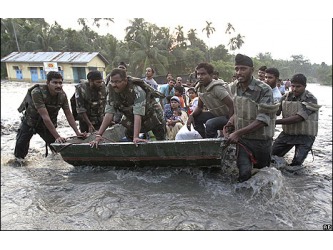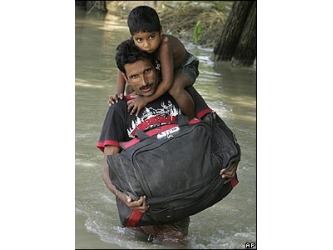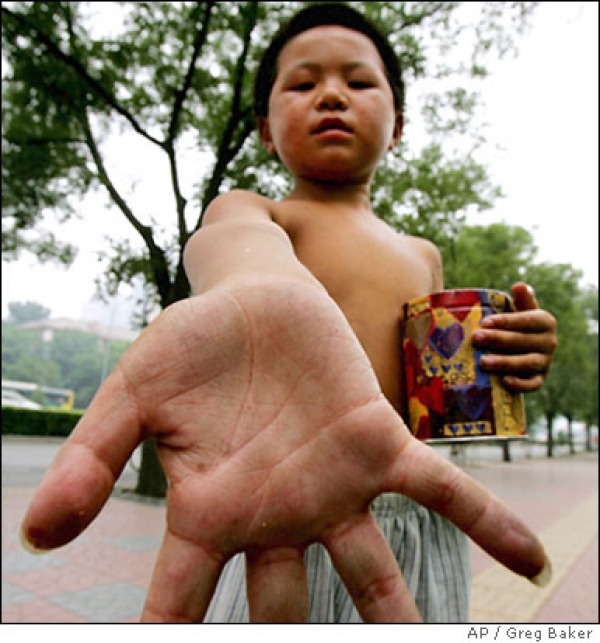BIHAR FLOOD INVESTIGATION ORDERED
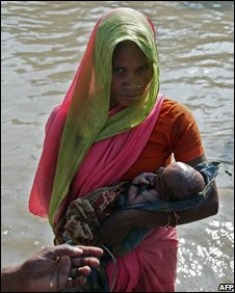
An inquiry has been ordered to find out whether official negligence contributed to devastating floods which hit the east Indian state of Bihar last month. Flood waters swept through the state after bursting through a dam on the Kosi River in neighbouring Nepal. With vast swathes of Bihar still under water, a litany of accusations has emerged of incompetence and neglect. More than two million people have been displaced from their homes, and they are demanding answers. Should embankments on the Kosi river have been strengthened before the onset of the monsoon? Why was a series of warnings ignored and why did it take so long for the relief effort to get up to speed once disaster struck? Fingers have also been pointed at widespread corruption and bribery on both sides of the border with Nepal. It will take months for an official investigation to report and it will be months before the displaced can return to their homes. Nearly 1,000 villages have been submerged in Bihar. Hundreds of thousands of people are living in grim conditions in temporary camps, while even larger numbers have moved in with friends and relatives or have migrated to other parts of the country
SOURCE--BBC
SORROW OF BIHAR IN PICTURE--source BBC
SOCIAL NEWS
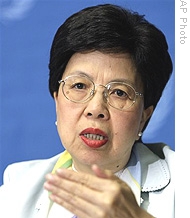
India hosts meeting of health Ministers from South-east Asia Press Information Bureau (press release)
Southeast Asia region should cooperate for public gains: India Thaindian.com
Pranab to inaugurate WHO-SEAR meetings on Monday Economic Times
all 48 news articles » Socio-Economic Reference Digital Database of Eastern States of ...
MarketWatch - 53 minutes ago
If the states of Bihar, Chhatisgarh and Jharkhand are states of mines, it is the West Bengal, which has contributed to Indian society in area of social ...
IBNLive.com IBN 7-Outlook to honour India's best states
IBNLive.com, India - 12 hours ago
THE BEST: The basis of recognition is the state's human development index and social growth. China denies trying to sabotage India's chances at the NSG. ...
IBN7 partners with Outlook for “IBN7 Diamond States Awards” indiainteracts.com
all 2 news articles » India-German trade to cross 30 bn Euros by 2010: Sibal
Economic Times, India - 13 hours ago
Apart from shared political, economic and social values, India considers Germany a very important collaborator in nation building. ... Eastern promise: The Big Issue's editor-in-chief on launching in India
Independent, UK - 7 Sep 2008
However, Bird's ambitions for India do not stop at the magazine; he wants it to encompass a bigger social purpose in the world's second most-populated ... India, China should work for peace and stability in Asia
Press Trust of India, India - 22 hours ago
... and social areas like sports and education, he said while expressing support for the chief minister's view that West Bengal was India's gateway to South ... BJP to look for winning poll strategy at leadership meet
Economic Times, India - 1 hour ago
... triumphal Congress that is seeking to highlight its policy successes over the India-US nuclear deal. "We will discuss the political, economic and social ...
SOURCE--GOOGLE
FRESH INQUIRY ON GUJARAT RIOTS
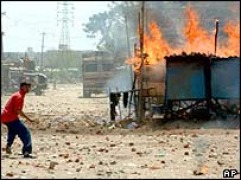
India's Supreme Court has ordered a fresh investigation into some of the worst cases during anti-Muslim riots in the western state of Gujarat in 2002. The court appointed a special police team to examine 10 cases of violence.
More than 1,000 people, mostly Muslims, died in the riots sparked off by an attack on a train carrying Hindu pilgrims, killing 59 of them.
The state's Hindu nationalist BJP government was heavily criticised for doing little to stop the violence.
Special team
The Supreme Court order follows consistent appeals by the victims' families and human rights groups which have accused the state government of indifference and even of conspiring to protect the accused.
Now the court has set up a special police team, consisting of three officers from the state and two from outside, to re-examine the cases and submit its report in three months.
"We had asked for an independent probe by a body such as the CBI (Central Bureau of Investigation)," said Teesta Setalvad, a rights activist representing the victims.
"The court has now appointed a special investigation team consisting of three Gujarat police officers and two very senior officers from outside the state," she said.
Gujarat's Hindu nationalist government, which has twice been re-elected to office since the riots, has accepted the court order.
More than 20 people have been convicted for involvement in riots in special courts set up outside the state but many others have yet to be brought to justice. SOURCE-BBC NEWS
UN praises India for 'swift' action in bird flu outbreak

NEW YORK: The United Nations has praised the "swift and comprehensive" measures taken by India to bring under control the "worst-ever" outbreak of bird flu in West Bengal, while urging the country to maintain vigilance in view of similar incidents reported in its neighbourhood.
The UN Food and Agriculture Organisation's veterinary expert Mohinder Oberoi said that intensive culling in the predominantly backyard poultry sector of West Bengal appears to have stopped the disease in its tracks.
Oberoi made the comment after a recent field trip to the affected areas, where no new outbreaks have been reported since February 2.
FAO's Chief Veterinary Officer Joseph Domenech, however, urged the country to maintain intensive surveillance in high-risk areas as the possibility of new occurrences remains high.
"The virus could still be present in the environment despite heavy slaughtering and extensive disinfection of affected areas, or it could be reintroduced from other countries," he said.
The FAO officials praised the national and state governments' political and financial commitment to stamp out the disease.
They said public awareness campaigns, a strong command chain from districts to villages, compensation payments and an effective collaboration between animal and human health departments at field level have been the key factors for the success. var RN = new String (Math.random()); var RNS = RN.substring (2,11); var b2 = ''; if (doweshowbellyad==1) bellyad.innerHTML = b2;
Bird culling intensified in Bengal
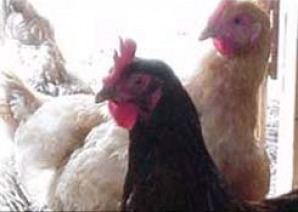
Sunday, January 20, 2008 (Kolkata)
The West Bengal government has stepped up the culling of birds in bird-flu affected districts of the state.
The move is part of the efforts to fight the bird flu outbreak in the state.
Bird-flu has now spread to five districts of West Bengal - Birbhum, south Dinajpur, Murshidabad, Nadia and Bardhaman.
The state government has said that four lakh birds must be culled by next Saturday in Birbhum alone, ground zero of the Bengal bird flu outbreak and the worst affected.
State animal resources minister Anis ur Rehman said the number of culling teams in Birbhum would be increased to 300 from 60.
This hasn't happened because not all the teams on the ready have been able to get doctors to accompany them, which is mandatory. As a result, only 100 teams are in action at the moment.
An attack on a culling team after a dispute over where the culled birds were to be buried resulted in injuries to five people.
The Indian Medical Association (IMA) is expected to send a team of doctors to bird-flu affected districts on Sunday.
Meanwhile, Minister of State (Health) Panabaka Lakshmi has said that she isn't satisfied with work of the culling teams.
No human beings have so far been affected by bird flu in India, Health Minister Anbumani Ramadoss said on Sunday.
''Not even a single case has been reported so far'', he told reporters here on the sidelines of a function.
Ramadoss said the Centre had instructed the West Bengal government to destroy all birds in the affected districts to control the disease. (With PTI inputs)
Minorities Panel Indicts Orissa Administration For Riots
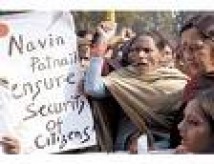
Thursday 17th of January 2008
The National Commission for Minorities (NCM) has indicted the local administration and the police of the riot-hit Khandamal district of Orissa for the communal violence on the eve of Christmas last year. It also hinted that Hindu organisations could have been involved in the violence.
The out-break of violence was a result of the long simmering conflict between Pana (Christian tribals) and Kui tribals, NCM member Dileep Padgaonkar said here Thursday.
Panas have been demanding reservation under the Scheduled Tribes category, which has been opposed by the Kuis.
Another important factor, according to the commission, was the anti-conversion campaign conducted by the Vishwa Hindu Parishad (VHP) and Sangh Parivar for the last few years.
The NCM members maintained that they found no case of forcible conversion or conversion through inducements.
The Kuis were also agitated as some Scheduled Castes Christians had allegedly obtained false caste certificates to benefit from reservations, the NCM said.
A two-member committee of NCM, comprising Padgaonkar and Zoya Hasan, visited the riot-affected districts of Orissa Jan 6-8.
When asked whether the riots were well planned, Padgaonkar said, 'There was enough evidence to suggest that the outbreak of violence in Khandamal was organised.'
'An anti-Christian atmosphere was created and there was large-scale destruction of Christian property.' He added that the local administration did not take appropriate and quick measures to control the mob.
Padgaonkar stated that 2,000 tress had been cut in a matter of two hours to block the roads leading to the riot-affected areas. 'This was done to delay the patrol parties from reaching the riot-affected areas. It shows that the riots were organized,' he said.
The commission appeared divided on whether the Navin Patnaik government was lax in controlling the violence and also on the issue of Sangh Parivar involvement in the violence.
Hasan said, 'From what we gathered, the VHP was in the background of the riots. But it is difficult to pinpoint that the men involved in the violence were from VHP.'
Padgaonkar said that Orissa Chief Minister Navin Patnaik appeared concerned about the riots. 'He has promised to look into the issues that we discussed with him,' he said.
'The local administration should not have allowed two bandhs (strikes) on the same day, knowing fully well that a big Christian festival was so close,' said another member of the commission.
The NCM has asked the Orissa government to increase the compensation amount paid to the victims, as the money given was meagre.
'It should at least match the amount paid by other states in similar cases,' Padgaonkar said. The speech given by Swami Lakshmananda - who allegedly tried to incite the locals-- should be examined to find out if he tried to whip communal passions, he added.
Three people were killed - among them one Hindu and a Christian, while the identity of the third is yet to be established - in the communal flare-up Dec 25, 2007 in Khandamal district. Many Christian institutions - Churches, shops and schools -were destroyed in the riots.
Chief Minister launches Hepatitis B immunisation
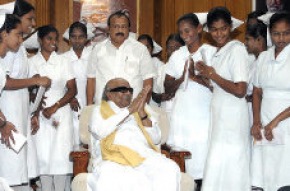
CHENNAI: Tamil Nadu on Sunday pioneered the inclusion of the Hepatitis B vaccine in the routine childhood immunisation programme.
Chief Minister M. Karunanidhi launched the immunisation initiative, along with a slew of healthcare schemes, to make Tamil Nadu the first among the 15 States short-listed by the Centre for the Hepatitis B universal immunisation programme.
Mr. Karunanidhi also launched a 100-strong fleet of mobile medical units and a computerisation programme for Primary Health Centres, besides distributing appointment letters to 1,000 staff nurses and 66 sanitary inspectors.
Health Minister M.R.K. Panneerselvam, Electricity Minister Arcot N. Veeraswami and Chief Secretary L.K. Tripathy were present.
The Hepatitis B immunisation initiative targets an estimated 11.5 lakh newborns a year. The programme, which will cost Rs. 7.20 crore each year, will be implemented through all government hospitals, Primary Health Centres and health sub-centres.
The vaccine, declared by the World Health Organisation the seventh in the Expanded Programme of Immunisation, will be given within 72 hours of birth and will prevent vertical transmission (from mother to child), besides helping the children avoid lethal Hepatitis B-related complications.
The free-of-cost immunisation will run concurrently with BCG, TT, DPT, DT, polio and typhoid vaccination initiatives.
The mobile medical teams will take screening facilities for women, children and the elderly closer to rural people under the National Rural Health Mission. Each will provide easier access than the Primary Health Centre. The mobile team will comprise a doctor, nurse, paramedical staff and a sanitary worker.
The scheme, piloted in 2006-07, is expanded in response to the popular support it received, says a release.
The plan is to establish mobile teams one per block of one lakh of the population and cover all 385 blocks by next year, Public Health Director P. Padmanabhan said.
The Chief Minister also inaugurated a computerisation scheme for 1036 Primary Health Centres, which will be equipped with computers and the Internet connectivity.
Fight against AIDS, TB gets $100m boost

NEW DELHI: India's fight against three deadly diseases — HIV, malaria and TB — has got a $153 million boost for use over the next three years.
The Global Fund to Fight AIDS, Tuberculosis and Malaria, created by the G-8 group of industrialised nations in 2002, on Thursday signed a grant agreement with India's department of economic affairs allocating over $100 million to fight AIDS and $53 million for malaria.
The move brings the total approved amount of global fund resources in India to $492 million since 2005. This new commitment has made India Asia's largest beneficiary of the charity.
"Total proposals approved for India is to the tune of $747 million to fight the three diseases and so far we have signed an agreement for $492 million, out of which $160 million has already been disbursed," fund executive director Michel Kazatchkine said.
"Since AIDS is a huge threat, we are utilising 80% of the resources for this disease. The $100 million grant will help India buy second line drugs from UNITAID or Clinton Foundation, purchase viral load machines, strengthen and scale up antiretroviral treatment programmes and support voluntary counselling and testing services," Naco DG K Sujatha Rao said.
Union health minister A Ramadoss said, "We have done a good job in containing TB and AIDS. Malaria is our concern now. It is endemic throughout India, specially in the north-east, West Bengal and Jharkhand. In the next three months, we will upscale our resources and efforts to fight malaria."
The Switzerland-headquartered international charity's support to India has provided ARV treatment to 80,000 people living with AIDS and TB treatment to more than 245,000 people. It has also financed the distribution of approximately 1.5 million insecticide treated bed nets to families at risk of contracting the disease.
Since its creation in 2002, the Global Fund has become a big financier of programmes to fight AIDS, TB and malaria, with approved funding of $10 billion for more than 520 programmes in 136 countries.
Kazatchkine and Rajat Gupta, the chair of the Global Fund board, are currently in India to visit global fund-supported programmes and meet with civil society and government officials.
[email protected]
var RN = new String (Math.random());
var RNS = RN.substring (2,11);
var b2 = '';
if (doweshowbellyad==1)
bellyad.innerHTML = b2;
Will these turtles survive?

P. Devarajan
A LATE evening, some months ago, one released a new born Oliver Riddley turtle into the Arabian Sea. Vivek Bendre and myself felt sad as the chick struggled with the waves before getting lost. He will be growing up (if predators do not snap him up) alone as the mother turtle does not go beyond laying eggs in a hole on a sandy beach.
That moment will always be with this writer. But will Oliver Ridley turtles be around? They may not be, if the Orissa Government continues to okay steel and bauxite projects in the State.
Most of them could be accessing the Dhamra and other ports, opening into the sea lanes (Bay of Bengal) used by the Oliver Riddley turtles. Tata Steel has been taking the initiative to study the area around the Dhamra Port Project.
In a detailed e-mail, Sanjay Choudhry, Chief Press Relations Officer, Tata Steel, informed this paper that "Tata Steel has been having a dialogue with different environment groups partly to enlighten them on the truth about the port location vis-à-vis the turtle nesting area (many of them indeed did not know the actual location of the port which is sufficiently away from the turtle nesting area) and partly to know all the view points, concerns and apprehensions so that the problem could be squarely addressed.
"In one such meeting, it was pointed out how all available studies show that the coast of Orissa north of the river Dhamra is not frequented by turtles, a fact verified on site by the National Appellate Authority on Environment before they upheld the environment clearance. It was then pointed out by some that the area north of the river Dhamra can be further studied to remove all doubts and the name of WWF-India was suggested as an independent agency. Before, however, this study could be completed, a suggestion came that a more comprehensive study through experts suggested by a number of organisations under the aegis of the Bombay Natural History Society may be more useful. Tata Steel and the promoters of Dhamra port have always been positive in their response to any suggestion for further study ... .."
Tata Steel has decided to fund the BNHS research project with the final agreement yet to be signed.
"This is not exactly an EIA as the statutorily required EIA (Environment Impact Assessment) has already been done. This is more in the nature of a study on what effects the port can have, if at all it will have, on the conservation of turtles and measures necessary to obviate such effects. ... For the present, the groups consulted have asked for study during one season only," explains Mr Choudhry and adds, "No steel project has been planned at Dhamra. It is only the port. ... . The construction of the port, therefore, has to go on as per schedule. The findings of the further study are not yet known and therefore any such conjecture as to whether the project would be scrapped is purely hypothetical."
In a second e-mail, Choudhry clarified that "Tata Steel's new greenfield project for a 6-million-tonne steel plant is on schedule and we are going ahead with it. Land has been taken and equipment orders have been given. Dhamra is not the only evacuation point as the plant is not necessarily only for foreign markets but more for domestic. Historically we have exported only 13-15 per cent of products."
Seemingly work on the port and steel project are on. If that be so, ecological studies in the future by the BNHS may not be binding. Naturalists are worried. In a detailed letter to the BNHS, Biswajit Mohanty, co-ordinator, Kachhapa, has argued for a complete EIA study including telemetry studies covering both prime and non-prime turtle seasons for two years at least. Pushing on, the letter wants BNHS to insist, "that no port construction activity should commence till the EIA study is complete," apart from extending the EIA to cover "the proposed steel plants, rolling units, coking coal units likely to come up at the Dhamra port as well".
Perhaps, the letter sent by Ashish Kothari to BNHS is more revealing. "There is evidence to prove that in the late 1990s, two protected areas in the region, the Bhitarkanika National Park (BNP) and the Gahirmatha Marine Sanctuary (GMS) were compromised to allow for the Dhamra port," Kothari states.
In the draft notification for the BNP issued in 1988, the total area of the proposed PA was about 370 sq.km. The proposed port site was well within the boundaries of this PA, which meant that at the time, the area was considered important for wildlife; in December 1997, a fresh proclamation was issued whereby the proposed boundary of the PA was redrawn so that the port site fell outside; the BNP was finally notified in Sept. 1998, with a total area of only about 145 sq.km which placed the port site outside the park.
When this question was put to Tata Steel, Choudhry replied: " It is not understood how Tata Steel or the port project would be in the picture if the national park or the sanctuary limits were reduced way back in 1988 before the port project was conceived by the promoters. As far as we know the limits after being finally notified have not been reduced. Any change made between preliminary notification and final notification based on hearing of objections would have been normal as the very purpose of preliminary notification is to hear such objections and make necessary changes."
One wonders: Are there any keepers for Oliver Riddley turtles? { SOURCE-BUSINESS LINE}
Britain to tighten immigration law

Press Trust of India
Sunday, December 16, 2007 (London)
In a fresh attempt to tighten the immigration law, Britain plans to propose restrictions on millions of people coming to the UK on temporary visas every year from outside the European Union, including those who take advantage of a system of ''sponsored family visits.''
Families with temporary visas who ''sponsor'' visits of their relatives abroad may have to put up a cash bond, possibly of 1,000 pounds, before their visitors are allowed in.
The move is also set to see the ordinary tourist visa having its limit halved from six months to three months.
The plan will potentially affect those coming to Britain on temporary visas every year from outside the European Union, including Indians.
''Over the next 12 months we will see the biggest shake-up of the immigration system in its history. The final front, I believe, is foreign visitor routes where change is needed,'' Immigration Minister Liam Byrne told The Sunday Telegraph.
The crackdown comes as Prime Minister Gordon Brown's Government seeks to regain the political initiative, following a series of crises over the past few months which have seen Labour's support plunge in the opinion polls.
One survey has put the party 11 points behind the Conservatives. The Prime Minister and senior ministers intend to use the issue of immigration and plans for stronger borders as part of a New Year initiative to outflank the Tories, who they claim are weak on the matter.
School shootout leaves Gurgaon horrorstruck

Tuesday, December 11, 2007 (Gurgaon)
It's a parent's worst nightmare come true. A class 8 student at the Euro International School in Guragon, on the outskirts of Delhi, was shot dead by two of his classmates after school hours on Tuesday.
Abhishek Tyagi was found dead in his school corridor with 3 bullets in his body.
At 2 pm (IST), a bus driver heard gunshots and raced to find a 13-year-old he often brought to school, lying in a pool of blood.
Abhishek Tyagi, a class 8 student, was shot five times at close range over a disagreement. The two accused allegedly took turns shooting him with the same gun.
One of the students reportedly smuggled the weapon into the school by hiding it in his socks. They hid it in the school toilet before using it on Abhishek. Both the accused have been arrested by the Police.
The Police Commissioner of Gurgaon described what led to the shooting.
''Akash Yadav took his father's revolver, hid it and carried it to school. He then put it in the school bathroom. In the evening when everyone left he fired at Abhishek. He fired four rounds and then he gave the pistol to his friend. He too fired a bullet.
''They had a fight sometime back. The matter was taken to the Principal but perhaps the matter wasn't resolved completely,'' said Mohinder Lal, Police Commissioner, Gurgaon.
Abhishek Tyagi, who was walking in the corridor soon after school closed for the day, was accosted by Akash Yadav and Vikas Yadav over an old grudge.
Akash pulled out his father's licensed revolver and allegedly shot Abhishek four times, handed the gun to Vikas who fired another bullet.
Of the bullets fired, one struck Abhishek in his temple and two in the chest, killing him immediately.
School chairman Satbir Singh said the authorities had not yet been able to talk to the principal and class teacher to learn the details of the incident.
The Euro International School, in its website, claims to be one of the top boarding schools of the area and has set up cameras throughout the campus to monitor each and every activity in and outside the classroom.
Meanwhile, At abhishek's home a sense of disbelief prevails over a senseless loss that could have been averted.
The recent incident lays claim to the rising instances of juvenile crime in the national capital region. (With PTI inputs)
CID to probe Nandigram graves

Press Trust of India Friday, December 7, 2007 (Kolkata) The West Bengal government today ordered a CID inquiry into the identities of the persons whose charred bones and portions of skull were exhumed from five crudely-dug graves at Bamanchak near Nandigram yesterday.
''The CID has been asked to inquire into the matter,'' Home Secretary Prasad Ranjan Ray told reporters.
Stating that DNA tests would be conducted to ascertain the identities of those whose remains had been found, he said that the bone samples would be sent to the Central Forensic Science Laboratory for examination.
For identification purpose, the DNA from the bones would be matched with those of near relatives of those claimed to have been killed in Khejuri, Ray said.
Yesterday, East Midnapore superintendent of police Satyeswar Panda said that the bones could be of the five killed while making bombs on October 28, or those who had died on March 14, or in violence on November eight during the recapture of Nandigram.
Zilla Sabadhipati Niranjan Sihi had claimed that the bodies were of party supporters from Gokulnagar and Belda, who were killed in a bomb attack allegedly by Bhumi Ucched Pratirodh Committee supporters on October 28.
Sihi claimed that the bodies were those of Bachchan Gurudas, Sunil Bar, Gourlaya Das, Simanata Das from Gokulnagar and Govinda Singh from Belda
nandigram show
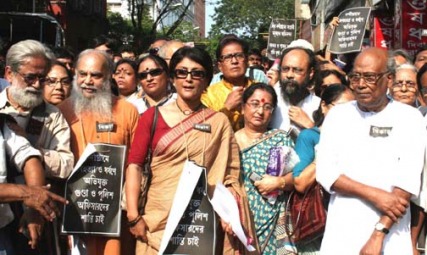
The organised brutality by the CPM in Nandigram has yet again brought out the best among the people of Bengal and Kolkata. In the days to come, one only hopes that the civil society will continue to move from strength to strength, from dissent to resistance, from despair to hope, writes Rajat Roy, Hardnews in Kolkata
The CPM has recaptured Nandigram. But in the process the party has lost its support base among the urban middle class. A huge silent march was led by Kolkata’s artists, intellectuals, students and ordinary citizens, outside all political affiliations, banners or slogans, in the heart of the city. The march was in protest against the State-endorsed operation of organised brutality unleashed by the CPM cadres and musclemen in Nandigram leading to killings, while thousands of villagers were rendered homeless, with many homes burnt.
The protest march was led by filmmakers Mrinal Sen, Aparna Sen, Rituparno Ghosh and Goutam Ghosh, poet Sankho Ghosh, Jay Goswami and Utpal Kumar Basu, writer Mahasweta Devi, stage personalities Saoli Mitra, Bibhas Chakrabarty and playwright Badal Sarkar, painters Jogen Choudhury and Shubhaprasanno and others. The unique feature of the march was that political leaders were asked not to take part in it. Hence, bowing to public pressure, the leaders of Trinamul Congress (TMC), Congress, the Socialist Unity Centre of India (SUCI) and even Left Front partner Revolutionary Socialist Party (RSP), though initially keen to join it, kept away from it. Indeed, the space vacated by the political parties was eagerly filled up by the civil society and a spectrum of individuals and icons from across Bengal’s mainstream intelligentsia and cultural scene.
Scientists from the Saha Institute of Nuclear Physics and other scientific establishments, social
scientist Partha Chattopadhyay, historian Gautam Bhadra and others from Calcutta's prestigious Centre for Social Science and Research, academicians and students from Calcutta and Jadavpur University, students from various colleges, NGO workers and ordinary citizens came forward in tens of thousands. They recorded their intense anger, disapproval and disgust at the way the ruling party's vigilante cadres, openly flaunting brutality on unarmed men and women, including reported sexual assaults and rape, as they muscled their way into Nandigram while the State administration and political establishment remained a silent and patronising accomplice.
This revolting ‘operation recapture’, which Governor Gopal Gandhi, grandson of Mohandas Karamchand Gandhi, had only a few days back condemned publicly as "totally unlawful and
unacceptable", has generated similar resonance from across the civil society. Kolkata had not witnessed this kind of mass upsurge against the CPM regime for almost three decades.
It was a silent march. There were no slogans which is otherwise typical of a political procession in the city. People who participated in the march wore black badges, others sang songs, many of them carried placards and caricatures criticising the CPM and Chief Minister Buddhadeb Bhattacharya, who has acquired an image which triggers mass repulsion. The massive rally began from College Square in front of the old campus of Calcutta University and ended at Esplanade East, where Medha Patkar and others welcomed the marchers. As the people silently walked through the famous College Street, SN Banerjee Road and Rani Rasmoni Road, thousands of people thronged on both sides in solidarity. The solemn expression on the faces of the onlookers indicated the truth: they were witnessing something which they have not seen for years.
Yes, this protest march is unique in many ways. Kolkata has witness several political demonstrations in the last 60 years. But most of that were organised by political parties. Many senior citizens who took part in this historic march could not recall a similar occasion where ordinary people from across the city gathered so spontaneously and in such big numbers to protest against the political establishment.
It is true that the ostensive purpose of the rally was to record the civil society's protest against the ruling party's brazenly undemocratic use of organised violence and brutality backed by the state administration. But by debarring the (ever-willing) opposition parties like the TMC and Congress, the civil society has served its judgment against the entire political stablishment. The political world just cannot afford to ignore this.
Many participants admitted that they happily joined the march because of this abhorrence of mainstream politics and politicians. They have reasons for that. Most people here have inherited a Left legacy. They have always constituted the progressive and traditional support base of the Left in the urban middle class. Many former naxalites were seen in the rally. Young students from elite colleges like St. Xavier's, Presidency, Jadavpur University and Shibpur Engineering College marched hand in hand in the procession with members of pop Bangla bands and singer Usha Uthup.
Ask them, and you would realise that their first baptism in social and political action was done during the case of Rizwanur death. The ‘indifferent’ generation X, considered as totally apolitical, totally sold out on the ‘neo-liberal’ shopping mall and inox culture, actually proved to be deeply sensitive and concerned. It is also an eye-opener for political observers.
Indeed, after seeing the CPM-led Left Front entrenched in power for the last 30 years in the
state, many of us looked at the Bengali society as a bipolar one, divided between the Left and the Right.
It was always held that Bengal's society is highly politicised and there is hardly any space left for
the civil society to assert. The inert and sustained presence of the civil society over the years and until the recent past had also strengthened that observation. But from March 14 to November 14 this year, in just about eight months, the civil society of Bengal has reasserted itself and started claiming back its legitimate space in the socio-political sphere, hitherto completely dominated by the creative stagnation and political muscle power of the CPM, without an iota of dissent.
Off course, the mass rupture and upsurge started with the resistance in Nandigram and the massacre which followed, when on March 14 the police and CPM goons fired upon the villagers in an attempt to evict them from their villages to set up a chemical hub for the notorious Indonesian multinational Salem. Then came the Rizwanur death, when the young and the old fought and forced a completely thick-skinned government to bow to their demands and act against the police top brass, patronised by the chief minister. Now, the organised brutality by the CPM in Nandigram has yet again brought out the best among the people of Bengal and Kolkata. In the days to come, one only hopes that the civil society will continue to move from
strength to strength, from dissent to resistance, from despair to hope.
SOURCE -HARD NEWS SERVICE
ground reality
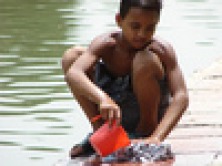
SHGs help combat iodine deficiency disorder 30.11.2007 Small salt producers in the Indian western state of Rajasthan are partnering NGOs and the government in the campaign against iodine deficiency disorders. According to the WFP, Nawa now produces iodised salt as per the national standard.
more...
From: OneWorld South Asia
Related topics/regions: [South Asia] [Knowledge] [Health] [Food] [Capacity building] Image: Women working at the salt production site Hiv:stä on tehtävä numero, vaatii intialaisaktivisti 29.11.2007 Kondomit eivät auta, jos niitä ei käytetä ja jos naisilla ei ole valtaa niitä vaatia. Hiv-valistuksessa tärkeintä on opettaa tytöt tuntemaan itsensä ja rajansa, intialainen Heather Ferreira sanoo.more...
From: maailma.net
Related topics/regions: [AIDS] Indian Muslim women reinforce campaign for rights 29.11.2007 Hundreds of Muslim women from across India, along with academics, social experts and parliamentarians, addressed social, livelihood, legal and religious issues of the community at the first annual convention of Bharatiya Muslim Mahila Andolan (BMMA) in Delhi. The campaign also called for the implementation of the 2006 Justice Sachar Committee report for better education and employment facilities.more...
Related topics/regions: [South Asia] [Governance] [Civil society] [Social exclusion] [Gender] [Education] National conference on e-Governance 29.11.2007 The XI National Conference on e-Governance in India, to be held on February 7-8, 2008, will focus on the national awards for e-Governance 2007-08. The event will be organised by the Department of Administrative Reforms and Public Grievances (DAR&PG) in collaboration with the Department of Information Technology. more...
Related topics/regions: [South Asia] [Governance] [ICT] Campaign spreads awareness on domestic violence law 29.11.2007 Organizations and networks across 41 districts of Uttar Pradesh, India’s biggest northern state, have come together to campaign on the Domestic Violence Act, as part of the 16 Days of Activism against Gender Violence. more...
Related topics/regions: [South Asia] [Law] [Activism] [Internet] [Information & media] [Gender] Hidden Stories Start Gender Violence Campaign 27.11.2007 Domestic violence in the Russian Federation; sex slavery in India; self-immolation in Central Asian republics; gender-based violence and HIV; and 'compensation' marriages are the five underreported stories used by the UN Population Fund to launch a campaign against gender-based violence.
From: UNFPAmore...
Related topics/regions: [Uzbekistan] [Tajikistan] [Russian Federation] [Pakistan] [Iraq] [Iran] [Middle East] [Africa] Image: Activists rally to stop violence against women. © Amnesty International USA Related links Perspectives Magazine: Gender Matters Second National Conference of Dalit Organisations 27.11.2007 The national platform for Dalit organizations in India, NACDOR, will hold its second national conference from December 5-8, 2007 in New Delhi. Over a thousand Dalit organizations will participate at NACDOR-II to finalise a comprehensive Dalit agenda, while tackling current challenges to the marginalized communities.more...
Related topics/regions: [South Asia] [Civil society] [Social exclusion] [Human rights] A pink crusade for justice 27.11.2007 A group of women is fighting social ills in Banda, one of the poorest, caste-ridden and chauvinistic societies in India’s northern state of Uttar Pradesh. Dressed in pink saris, these women fear not to wield sticks on the corrupt when need be.more...
Related topics/regions: [South Asia] [Law] [Corruption & transparency] [Gender] Image: The 'pink gang' © BBC Intialainen vaatefirma uhkaa arvostelijoitaan pidätysmääräyksellä 22.11.2007 Intialainen vaatetusyhtiö Fibre & Fabrics International uhkaa kansainvälisellä pidätysmääräyksellä järjestöjä, jotka ovat arvostelleet yhtiön Bangaloren tehtaiden työoloja. Yhtiö hakee kansainvälistä pidätysmääräystä, jonka nojalla Intiassa oikeuteen haastetut arvostelijat voidaan pyytää luovutettavaksi Intiaan mistä tahansa maasta. Oikeus päättänee pidätysmääräyksestä huomenna perjantaina.more...
From: Suomen Ammattiliittojen Solidaarisuuskeskus
Related topics/regions: [Law] [Labour] Image: © New Internationalist Mobile AIDS testing vans spread the message 22.11.2007 Ten vans will travel to the remote interiors of Tamil Nadu, India’s southern state, to help people test for HIV/AIDS in a programme supported by the Red Cross Societies. According to National AIDS Control Organisation (NACO), India has 2.5 million people infected by the virus.more...
Related topics/regions: [South Asia] [MDGs] [Knowledge] [AIDS] [Health] Image: The AIDS ribbon On the ivory trail 22.11.2007 The Indian elephant is in danger as the numbers of young breeding tuskers fall to a mere 1,200. Coordinated efforts on part of enforcement agencies and better border management can contribute towards fighting poachers and organized crime, says B K Sharma, head of the State Crime Branch of Orissa and leading expert on the illegal wildlife trade.more...
Related topics/regions: [South Asia] [Law] [Forests] [Conservation] [Animals] Image: Elephants on the brink/ photo credit: Nayan Khanolkar © Sanctuary Asia Barefoot teachers usher in change 21.11.2007 The Vanasthali Rural Development Centre (VRDC) in Pune was started with a simple thought: to train rural women to enable them start balwadis or nurseries in their villages. Years later, activist Nirmala Purandare's dream has heralded a social revolution with the training of barefoot teachers in the Indian state of Maharashtra.
more...
From: OneWorld South Asia
Related topics/regions: [South Asia] [Activism] [Poverty] [Education] [Capacity building] Image: Teachers taking a balwadi class Community radio gets a boost in India 19.11.2007 Seven NGOs have been approved by the Ministry for Information & Broadcasting to set up community radio stations in India. This follows the Ministry’s year old decision to broadbase its policy to include non-governmental organizations apart from educational institutes and agricultural groups. more...
Related topics/regions: [South Asia] [Knowledge] [ICT] [Information & media] [Capacity building] Image: Radio for Dalits YES Fund for young entrepreneurs 19.11.2007 YES (Youth Employment Systems) Fund – the Global Fund for Youth Entrepreneurship – has announced its ICT Business Plan Competition for year 2007-2008. Winners will be judged on the basis of most innovative ideas and business plans in India and Kenya.more...
Related topics/regions: [Kenya] [ICT] [Business] [Youth] Ban on grazing reaps returns 19.11.2007 There is nothing official about it. Yet, the ban on grazing imposed by local farmers in some villages of Ahmednagar in the Indian state of Maharashtra has led to remarkable results. more...
From: OneWorld South Asia
Related topics/regions: [South Asia] [Conservation] [Land] [Agriculture] Image: Whose grass is it anyway? Let us compete in poverty eradication: Muhammad Yunus 19.11.2007 Muhammad Yunus, Nobel laureate and founder of the Grameen Bank, says Bangladesh will eradicate poverty by 2030 and wants India to take up the challenge as well. On a recent visit to India, he spoke on the bank’s role, poverty museums, and issues close to his heart.
more...
From: OneWorld South Asia
Related topics/regions: [Bangladesh] [South Asia] [MDGs] [Microcredit] [Poverty] [Development] Image: Muhammad Yunus Journalism prize for TB reporting 16.11.2007 A new cash prize will award print and web reporting on tuberculosis and the resistant strains of the disease in developing countries.more...
Related topics/regions: [South Asia] [MDGs] [Internet] [Information & media] [Disease] Image: A young boy holds a chest X-ray plate/ photo credit: Panos London City water and its waste management 16.11.2007 Learn how cities can do more with better management of water waste that gets generated everyday. Delhi based Centre of Science and Environment is conducting a course on waste water management from January 14-17, 2008 at its New Delhi premises. Registrations are now open. more...
Related topics/regions: [South Asia] [Knowledge] [Pollution] [Conservation] [Water/sanitation] [Cities] Image: Cities need better management of its water-waste No more violence, cry Nandigram villagers 15.11.2007 Forced to flee from their homes, the villagers of Nandigram now only want to be left in peace. The recent upsurge of political violence in this East Midnapore area in the eastern Indian state of West Bengal uprooted thousands now living in relief camps.more...
Related topics/regions: [South Asia] [Justice and crime] [Politics] [Human rights] [Land] Short Film: Living Service 15.11.2007 More...
Related topics/regions: [Disease] [Health] [Environment] [Economy] [Youth] [Social exclusion] [Poverty] [Land] Image: living service SOURCE-ONE WORLD SOUTH ASIA
New email warns of fresh targets
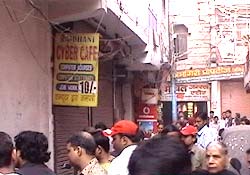
Saturday, November 24, 2007 (Lucknow)
Yet another threat has been received from the same email ID that sent a warning on Friday, moments before the serial blasts in UP that killed 13 people.
This time the email is naming new targets.
The email, received by a TV channel, specifies dates and targets but as the source of the email is still under investigation.
State and Central intelligence agencies are still examining Friday's email from a group called Indian Mujahideen, claiming responsibility for the blasts. But investigators believe that it could be just a smokescreen.
Sources claim that the email originated from the Saudi Arabian capital of Riyadh.
The email is suspected to have been sent from the Rajdhani cyber cafe in east Delhi. The police are questioning the owner.
In a related development, the Faizabad police released the sketch of fourth suspect in connection with the series of blasts in Lucknow, Varanasi and Faizabad.
Earlier, the UP Police had released sketches of three suspects in connection with the blasts.
While two sketches were prepared on the basis of eyewitnesses including lawyers and cycle stand attendants in Faizabad, another was released after questioning eyewitnesses in Lucknow.
Timer devices
According to sources, the investigation so far suggests that the blasts were triggered by a timer device and not by a remote or cell phones.
Also ammonium nitrate and other locally available explosives were used in the blasts.
Investigators are focusing on local sympathisers of terrorists who frequent the courts to meet lawyers.
State and Central intelligence agencies are also examining the email that was sent to a private TV channel from a group called Indian Mujahideen claiming responsibility for the blasts. They believe that it could be just a smokescreen.
The Bangladesh based banned organisation Harkat-ul-Jehadi Islamia or HUJI is suspected to be behind the blasts.
Investigators are looking at the modus operandi of the perpetrators and the use of materials like ammonium nitrate.
NDTV also spoke to Virendra Sharma, former advocate general of UP and a politician, who said the blast was perhaps an act attempted at demoralising the judiciary.
Security is on high alert today in Uttar Pradesh, especially in Faizabad as a large number of people are gathering at the banks of the Saryu river for a ritual bath on the occasion of Kartik Purnima.
Bomb scare
Meanwhile, a day after multiple blasts across the state, a cracker blast triggered panic at the Mughalsarai railway station this morning.
Mughalsarai is about 20 kms from Varanasi, which was one of the cities targetted in Friday's terror strike.
The police first suspected a low intensity blast but within moments it was confirmed that the explosion was a harmless cracker burst.
Blame game
But was it an intelligence failure or lack of communication between the state and the Centre?
The blame game has started with the Mayawati government accusing the Centre of not giving adequate warning about a possible strike.
Union Minister of State for Home Sriprakash Jaiswal, however, dismissed the charge.
Powerful cyclone kills 600 in Bangladesh

Friday, November 16, 2007 (Dhaka) Nearly 600 people were killed and thousands others, mostly fishermen, went missing as one of the worst cyclones in decades accompanied by huge waves and torrential rains battered Bangladesh's southwestern coast, destroying houses and affecting power supply countrywide.
At least 500 trawlers with over 3000 fishermen have been missing since cyclone Sidr, packing winds upto 240 km, made landfall at Khulna-Barisal coast on Thursday evening and swept central Bangladesh, including the capital Dhaka.
The Army backed by air force choppers was called in to help in rescue efforts with the death toll reaching near 600, television channels in Dhaka reported.
Barguna district was worst affected where over 120 people were killed. Local residents claimed to have seen nearly 500 bodies in Barguna.
The storm has now weakened and fortunately, the damage in West Bengal and Orissa is much lower than was earlier being feared.
After the cyclone, there was complete blackout and thousands have been left homeless. Those affected have been shifted to makeshift shelters.
''Last night a strong storm hit the city. It destroyed our makeshift house and wet all our clothes. At midnight we, together with our children, took shelter at another place,'' said Hazera Begum, a victim.
Since Thursday, the storm has weakened considerably. The attention now is to assess the damage and distribute aid.
But with Dhaka's main airport suspending operations, river ferries are not running and roads are blocked by uprooted trees. Several districts are cut off from the mainland.
The storm fortunately spared Orissa and West Bengal, which were also in its path.
Though it rested over Tripura and Assam on Friday morning, there was no damage. Heavy rains are expected in the region for the next 48 hours but the worse seems to be over. (With PTI Inputs)
SOURCE-NDTV
